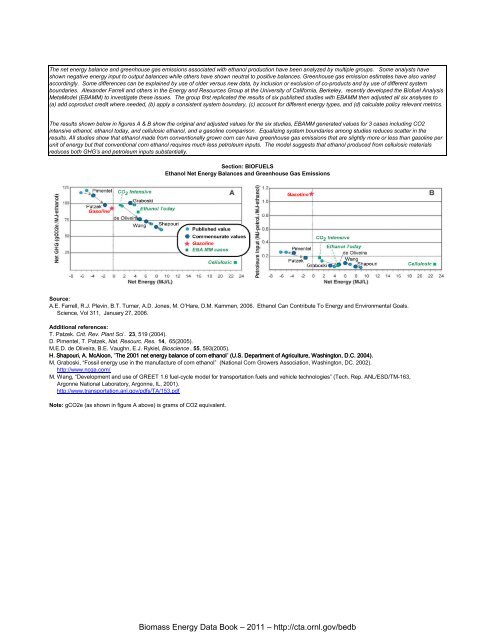Biomass Energy Data Book: Edition 4 - Full Document - Center for ...
Biomass Energy Data Book: Edition 4 - Full Document - Center for ...
Biomass Energy Data Book: Edition 4 - Full Document - Center for ...
You also want an ePaper? Increase the reach of your titles
YUMPU automatically turns print PDFs into web optimized ePapers that Google loves.
The net energy balance and greenhouse gas emissions associated with ethanol production have been analyzed by multiple groups. Some analysts have<br />
shown negative energy input to output balances while others have shown neutral to positive balances. Greenhouse gas emission estimates have also varied<br />
accordingly. Some differences can be explained by use of older versus new data, by inclusion or exclusion of co-products and by use of different system<br />
boundaries. Alexander Farrell and others in the <strong>Energy</strong> and Resources Group at the University of Cali<strong>for</strong>nia, Berkeley, recently developed the Biofuel Analysis<br />
MetaModel (EBAMM) to investigate these issues. The group first replicated the results of six published studies with EBAMM then adjusted all six analyses to<br />
(a) add coproduct credit where needed, (b) apply a consistent system boundary, (c) account <strong>for</strong> different energy types, and (d) calculate policy relevant metrics.<br />
The results shown below in figures A & B show the original and adjusted values <strong>for</strong> the six studies, EBAMM generated values <strong>for</strong> 3 cases including CO2<br />
intensive ethanol, ethanol today, and cellulosic ethanol, and a gasoline comparison. Equalizing system boundaries among studies reduces scatter in the<br />
results. All studies show that ethanol made from conventionally grown corn can have greenhouse gas emissions that are slightly more or less than gasoline per<br />
unit of energy but that conventional corn ethanol requires much less petroleum inputs. The model suggests that ethanol produced from cellulosic materials<br />
reduces both GHG’s and petroleum inputs substantially.<br />
Section: BIOFUELS<br />
Ethanol Net <strong>Energy</strong> Balances and Greenhouse Gas Emissions<br />
Source:<br />
A.E. Farrell, R.J. Plevin, B.T. Turner, A.D. Jones, M. O’Hare, D.M. Kammen, 2006. Ethanol Can Contribute To <strong>Energy</strong> and Environmental Goals.<br />
Science, Vol 311, January 27, 2006.<br />
Additional references:<br />
T. Patzek. Crit. Rev. Plant Sci . 23, 519 (2004).<br />
D. Pimentel, T. Patzek, Nat. Resourc. Res. 14, 65(2005).<br />
M.E.D. de Oliveira, B.E. Vaughn, E.J. Rykiel, Bioscience , 55, 593(2005).<br />
H. Shapouri, A. McAloon, ”The The 2001 net energy balance of corn ethanol” ethanol (U.S. Department of Agriculture, Washington, D.C. 2004).<br />
M. Graboski, “Fossil energy use in the manufacture of corn ethanol” (National Corn Growers Association, Washington, DC. 2002).<br />
http://www.ncga.com/<br />
M. Wang, “Development and use of GREET 1.6 fuel-cycle model <strong>for</strong> transportation fuels and vehicle technologies” (Tech. Rep. ANL/ESD/TM-163,<br />
Argonne National Laboratory, Argonne, IL, 2001).<br />
http://www.transportation.anl.gov/pdfs/TA/153.pdf<br />
Note: gCO2e (as shown in figure A above) is grams of CO2 equivalent.<br />
<strong>Biomass</strong> <strong>Energy</strong> <strong>Data</strong> <strong>Book</strong> – 2011 – http://cta.ornl.gov/bedb
















